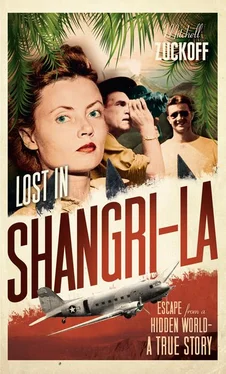Although the valley could serve no military purpose, news of its discovery spread quickly around Hollandia and beyond. Interest heightened when Elsmore began telling people that he thought the valley’s inhabitants looked much taller and larger than any other New Guinea natives he had seen. Elsmore’s impressions contributed to fast-spreading stories, or more accurately, tall tales, that Hidden Valley was populated by a previously unknown race of primitive giants. Some called them black supermen – handsome models of sinewy manhood standing over two metres tall. Soon the natives were said to be headhunters and cannibals, savages who practised human sacrifice on stone altars. The pigs the natives raised were said to be the size of ponies. The bare-breasted native women were said to resemble the curvaceous pin-up girls in soldiers’ barracks, especially the exotic, sarong-wearing actress Dorothy Lamour, whose hit movies included The Jungle Princess .
In time, the stories multiplied, largely because no one could contradict any claim, no matter how outlandish. And it seemed as though the stories would remain unchallenged. No one in Hollandia had any reason to hike 240 kilometres, past untold Japanese troops in hiding, over mountains, and through swamps and jungles. And no planes could safely land in the valley – the ground was too soft, uneven and grassy for a natural runway – and helicopter blades could not generate enough lift in the thin, high-altitude air to clear the surrounding mountains. Above all, the soldiers at Base G had a war to fight, not an anthropological expedition to mount.
Still, the valley captivated Elsmore. He asked around among Dutch and Australians whom he considered to be experts on New Guinea and found no evidence that any outsider had ever set foot in the valley.
____
As the stories spread, sightseers clamoured to see Hidden Valley with their own eyes. Over flights became a perk for officers, WACs, and enlisted men. Some returned with exciting stories of natives firing arrows and throwing spears at their planes. The more adventurous among them dreamed of touching the valley floor, even if it meant crash landing. ‘I suppose I would have regretted it,’ a lieutenant named William J. Gatling Jr wrote to his family in Arkansas, ‘but I feel I would have liked to have been forced down simply to get a good first-hand idea of the whole area. Flying over was like holding candy just out of reach of a baby.’
Gatling’s letter continued:
Quite a number of us were skeptical of what we had heard before we made the trip but our skepticism had all vanished by the time we returned. Some will and some will not believe this story … Beyond what has been observed from the air, it is believed nothing first-hand is known of these primitive people and their habits and customs. Sealed as they are in their Hidden Valley, they appear to be wholly self-supporting and self-sufficient. It is possible, of course, that they have some hidden footpath out of there, but such has not been located from the sky. Even if they could leave their valley, they would face a one-hundred-fifty-mile trek through almost impenetrable rainforest-type jungle to reach the Pacific coast in the north, or would encounter one-hundred-fifty miles of impassable, unexplored swamp extending between them and the Arafura Sea to the south.
After describing all he had seen during his flight, Gatling concluded his letter home with a philosophical thought: ‘Probably after the war the Dutch government will send an expedition into the valley or missionaries may penetrate it, so until then the natives … will know nothing of the white man except that he flies a big bird that makes lots of noise. Who knows, maybe they are much better off the way they are. At any rate, I am sure if they knew of the turmoil in which we are now engaged, they would be much happier to stay ignorant of the “civilized” world.’
____
The press got wind of the valley, and Colonel Elsmore agreed to take two veteran war reporters with him on one of his frequent flights over the valley, George Lait and Harry E. Patterson. Lait, in particular, had a lot to live up to. His father was Jack Lait, the pugnacious editor of the New York Mirror , who as a reporter in 1934 had filed an exclusive, on-scene story describing how the FBI gunned down bank robber John Dillinger. At thirty-eight, George Lait was on the way to matching his old man. As a swash-buckling correspondent for the International News Service, he palled around with legendary reporter Ernie Pyle and gossip columnist Walter Winchell; he was knocked out cold in London when shrapnel hit his helmet during the Blitz; and he had been blown out of a car seat by a German bomb. He had shot pheasants with King George VI, spent eighteen months with the British Eighth Army, and qualified as a paratrooper with the US Army’s 11th Airborne. Another reporter once said of him: ‘As a war correspondent, George was an inspired writer, fighter and souvenir collector. Where other correspondents might liberate a pistol or a helmet, George liberated machine guns, bazookas, tanks, and once had to be persuaded not to put the snatch on a Messerschmitt. It was a big war, George said, and he wanted something big to prove it.’
A man on his way to having seen it all, George Lait admitted that he had never seen anything quite like the valley. After returning from the flight with Elsmore, he filed a dispatch rich in description though tinged with racial and cultural condescension:
Skimming less than one-hundred feet over the valley floor, one was able to identify among the native crops banana trees, a water plant (swamp taro), extensive patches of the native sweet potato or yam, and a waist-high plant closely resembling tobacco.
Of animals, only a few dogs and pigs were seen. The pigs, staple meat food throughout New Guinea and religiously revered by most natives of the island, appeared exceptionally large and well kept, and of two varieties – an all-black or dark brown species, and a black and white variety, the latter growing to immense size.
When the plane first roared over the valley, crowds of natives ran from their houses and vanished into the standing crops or clumps of trees. But after flying down the valley several times, their child-like curiosity seemed to overcome their fear of the motors – they cautiously emerged to watch the soaring plane.
Harry Patterson’s story of the flight emphasized drama and intrigue: ‘Even today, weeks after the discovery that has the whole South Pacific buzzing with speculation, no white man and probably no regular native has set foot in the lost valley … It is pretty well-known in this part of the world that most of the New Guinea savages were either cannibals or head hunters.’ Patterson quoted Colonel Elsmore describing the valley natives as ‘taller, more finely built and lighter-skinned than the usual New Guinea fuzzy-wuzzies’.
The colonel, fancying himself an amateur geologist as well as a cockpit anthropologist, speculated that the natives’ ancestors came to the valley ‘hundreds or thousands of years ago’. ‘He thinks that after they settled in this mountain paradise an earthquake or some tremendous upheaval trapped them in the valley,’ Patterson reported.
As impressed as they were by what they had seen, Lait and Patterson were disappointed by the name Hidden Valley. Determined to re-christen it, they thought back several years to the Frank Capra movie, Lost Horizon , and its source, a 1933 James Hilton novel about a mysterious, peaceful utopia isolated from a war-weary world.
Hilton’s story revolves around the crash of a small plane into a Tibetan mountain. The survivors, one of them a woman, are rescued by monks who guide them to a bucolic valley where the inhabitants’ lives are long and happy, a land where moderation and tolerance reign supreme. In time, the survivors must choose whether to remain forever in the valley or return to the outside world, knowing that they might never be able to return.
Читать дальше












